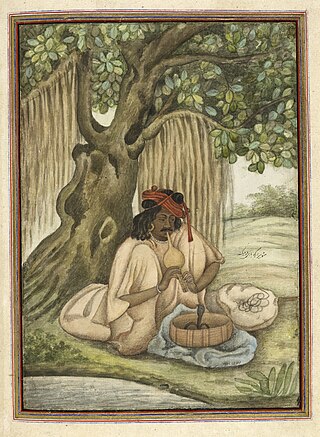Related Research Articles
The Bangali may refer to a Scheduled Caste found in northern India. They are distinct from the Bengali ethnic group of West Bengal. The Bangali are one of the many nomadic groupings found in India, and have customs similar to other nomadic communities such as the Kanjar.
Parmar, also known as Panwar or Pawar, is a Rajput clan found in Northern and Central India, especially in Rajasthan, Gujarat, Punjab, Haryana, Uttarakhand, Uttar Pradesh, Bihar, Madhya Pradesh and North Maharashtra. The clan name is also used by Kōḷīs, Garoḍās, Līmaciyā Valands, Mōcīs, Tūrīs, Luhārs, Kansārās, Darajīs, Bhāvasārs, Cūnvāḷiyās, Ghañcīs, Harijans, Sōnīs, Sutārs, Dhobīs, Khavāsas, Rabārīs, Āhīrs, Sandhīs, Pīñjārās, Vāñjhās, Dhūḷadhōyās, Rāvaḷs, Vāgharīs, Bhīls, Āñjaṇās, Mer and Ḍhēḍhs.
Meo, is an ethnic group of the Mewat region from north-western India, particularly from the Nuh district in Haryana and parts of adjacent Alwar and Bharatpur districts in Rajasthan. The term Mewati, although less common, is also used to refer to the ethnic group in modern discourse. They speak Mewati, a language of the Indo-Aryan language family, although in some areas the language dominance of Urdu and Hindi has seen Meos adopt these languages instead.
Muslim Rajputs or Musalman Rajpoots are the descendants of Rajputs in the northern regions of the Indian subcontinent who are followers of Islam. They converted from Hinduism to Islam from the medieval period onwards, creating various dynasties and states while retaining Hindu surnames such as Chauhan. Today, Muslim Rajputs can be found mostly in present-day Northern India and Pakistan. They are further divided into different clans.
Manjhi, sometimes recorded as Majhwar and as Majhi, is a community in the Indian states of Madhya Pradesh and Bihar, where they are classified as a Scheduled Tribe for the purposes of India's system of positive discrimination.
Ror is a caste found primarily in the Indian state of Haryana.
The Manihar are a Muslim community, found mainly in North India.
The Rangrez are a Muslim community found in North India. They are also known as Sabagh. Many members of Muslim Rangrez community have migrated to Pakistan after independence and have settled in Karachi, Sindh.
The Muslim Gaddi are a Muslim community found mainly in northern India. After the independence in 1947, the Gaddi of the states of Haryana and Delhi migrated to Pakistan and are now found in the provinces of Punjab and Sindh. In Pakistan and North India, some community members have started to refer to themselves as Ghazi in a way to reconstruct identity.
The Khanzada or Khan Zadeh are a cluster community of Muslim Rajputs found in the Indian states of Uttar Pradesh and Rajasthan. A notable community is the Khanzadas of Mewat, the descendants of Raja Nahar Khan, who are a sub-clan of Jadaun. They refer to themselves as Muslim Rajputs. After the Partition of India in 1947, many members of this community migrated to Pakistan.

The Sapera are a Hindu caste found in North India. They are also known as Barwa Sampheriya in West Bengal, Sapela in Punjab and Sparera in Madhya Pradesh.
The Ramaiya are a caste found in the state of Uttar Pradesh in India. Many members of this community migrated to Pakistan in 1947 and have settled in Punjab.

The Nat are a Hindu caste found in northern India.
Nalband is a Persian language word with the meaning manufacturer of horseshoes. The word is derived from the Persian word nal, meaning horseshoe and band, a fastener.
The Ahir is a Hindu caste amongst large set of pastoral communities using Yadav word since late 19th century to early 20th century as part of Sanskritisation process. The Ahir clans are spread almost all over country.
The Dabgar are a Hindu caste found in the states of Gujarat, Rajasthan, and Uttar Pradesh in India. They are also known as Dhalgar and have scheduled caste status in Rajasthan and Uttar Pradesh, while they have Other Backward Class status in Gujarat.In Rajasthan, the community prefer the self-designation is Dhalgar.
Phatak or Fatak is a clan (Gotra) of the Indian Ahir community.
Baniya, or Bania, is a clan of the Gurjar community of India and Pakistan. They speak Gujari in the Himalayan region and a number of other languages in the other locations where they inhabit. They practise Hinduism and Islam. They are Muslims in Kashmir and Pakistan, and Hindus in northern Indian regions.
Hun or Huna is a major ancient Kshatriya clan of the Gurjar community of Pakistan, Afghanistan, and India. Historically, they were also known by the name of Huna. Hun Gujjars are primarily Hindu, while some are Muslim in Muslim-majority areas especially in Kashmir and Pakistan. In mountainous areas, they speak the Gujari language, as well as other indigenous dialects. They are also mentioned in the Sanskrit epic of Mahabharat as the Hara Huna people. In past these Hun Gurjars ruled in various dynasties. Huns are also featured in the 36 Indian royal Kshatriya clan lists.
References
- 1 2 3 M. K. A. Siddiqui; Institute of Objective Studies (New Delhi, India) (2004). Marginal Muslim communities in India. Institute of Objective Studies. pp. 295–305. ISBN 978-81-85220-58-1 . Retrieved 1 June 2011.